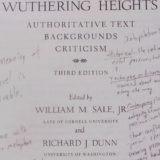The Greatest Literature Lecture You’ll Never Give
 Teachers talk too much in class. And language arts teachers talk even more than other teachers. I know, because I’m a language arts teacher myself. How do I shut myself up? How do I give students a greater voice in my classroom? As I tried to answer these questions I came up with an idea that has become one of the most talked about lessons my students experience.
Teachers talk too much in class. And language arts teachers talk even more than other teachers. I know, because I’m a language arts teacher myself. How do I shut myself up? How do I give students a greater voice in my classroom? As I tried to answer these questions I came up with an idea that has become one of the most talked about lessons my students experience.
At the end of every year I ask my students to list the activities they learned from and those they didn’t. And every year the majority of students list the “SO WHAT” lesson as an activity they will never forget. I still get alumni who come up to me five or six or ten years later and ask me if I still teach the “SO WHAT” lesson. So what is it?
It’s quite simple, really. But first, a few prerequisites:
- You must be in the middle of teaching a single novel to the whole class (I suppose you could also do this lesson with a book that you were reading to the class).
- The lesson needs to occur on the day after you’ve assigned a particular chapter to be read.
- You must have good classroom management in place. This lesson could go south quickly without solid control of the class.
- It has its most dramatic impact if the lesson occurs the first time you see students that day.
But how does the SO WHAT lesson work?
As students are arriving in class, try to be so busy that no one comes up to talk to you. If anyone does come to talk to you, answer them with curt nods or shakes of the head and try to direct them to their seats. Do NOT use your voice to answer them. You are about to run the class in COMPLETE SILENCE, but the students are not to know this.
Once everyone is seated, take out your copy of the novel and on the overhead write the name of the chapter they were supposed to have read. For instance, one year I assigned chapter 8 of The Hobbit, so I simply wrote “Chapter 8” on the overhead.
Underneath the title of the chapter, in all capital letters, write the words “SO WHAT?”
From this point on, using only gestures and facial expressions, your goal is to elicit answers to this question. It can take students 5-10 minutes to realize that you’re not going talk, and to understand what exactly you’re after. That frustration is vital to the significant experience that this lesson becomes by the end of class.
Here’s what I do next: I point at the words “Chapter 8,” then at the words “SO WHAT?” and I shrug my shoulders as if to say, “What’s the big deal about Chapter 8? Why should I care about it?” Then I wait. And wait.
Some years a bold student will raise his or her hand and start talking about the chapter. Most years no one says a thing. In that case, I pick out a student and point to them, making a gesture as if to say, “Come on, say something.” They usually look at me in a puzzled way, so I point to them again, then point to “Chapter 8.” They’ll laugh or get red, but eventually my persistence pays off as they ask, “Do you want me to talk about what we read?”
I nod my head yes, go back to the overhead and point to the words “SO WHAT?”
Usually the student will then begin to summarize the chapter, which is not what I want. What I want is for the class to start talking about significance of the chapter. So when the student is done summarizing, I may nod my head a little and make a so-so motion with my hand, but then I go back and point to “SO WHAT?”
If students still aren’t getting it, I might add this question to the overhead: “WHO CARES?”
At this point, some students begin to figure out that I’m not going to be speaking, and that it’s up to them to talk about what they’ve read. I always bring them back to the big question, “SO WHAT?”
As the class begins to understand what I’m asking them to do, other students will open up and offer reasons the text is important. At first they’ll try to discover the “right answer,” thinking that you want them to discover the magic interpretation. Resist this. Whenever a student asks you a direct question about the book, shrug your shoulders as if to say, “Maybe. I don’t know.” Then go back to, “SO WHAT?”
As they start to offer interpretations, a statement goes up on the overhead: “PROVE IT.” I’ll point to the student who made the interpretation, then point to “PROVE IT,” then open up the book and point to the text, trying to get the student to justify his or her answer.
You’ll be amazed and awe-struck as you listen to your students test and reject certain interpretations, then accept others as valid. In one discussion of The Hobbit, the class had almost determined that Bilbo represented Jesus and the dwarves in the company were the twelve apostles. Until someone remembered there were actually thirteen dwarves. Still, they had a fascinating discussion about how both the dwarves and the apostles were slow to understand their leaders’ ideas.
The beauty of this lesson is that you never know where the discussion is going to go, but by the end it always goes somewhere insightful, exciting and empowering. Though it begins in frustration, the SO WHAT class usually ends in passionate dialogue. It also leaves the students wanting more.
Before class ends I make it a point to talk, and the first words out of my mouth are, “Good job.” You should see the relief on their faces when I finally speak. They’ve just spent almost forty minutes on tough intellectual work, and my voice is the signal that it’s over. But then the processing starts: “I didn’t know what we supposed to do at first.” “Don’t ever do that again!” “That was cool.”It’s important that I help students own what they’ve done by reminding them of their conclusions about the text, and reminding them that they came up with those conclusions on their own, with no input from me.
The purpose of the lesson is two-fold: First, it gets me off the stage and gives the students a voice. Second, it forces students to process the reading themselves, to work together exploring the significance and meaning of a text.
I hope I’ve explained the SO WHAT class adequately. It’s a bit difficult to put into words because so much of it happens spontaneously. Leave comments if you have questions and I’ll answer them as best I can.













Wow. Really — this is terrific. I teach English/Language Arts to very high-level freshmen and remedial seniors (not both at the same time, thank goodness!). Because of the extreme differences in my students’ abilities, willingness, and maturity, I wonder what levels (age, experience, and ability you have used this lesson with.
Thanks for your comment and questions, Graycie! I enjoyed looking at your blog, and I’ve added it to my blogroll.
I use this lesson with eighth graders, but I think it would transfer to higher levels, too. Most students are so used to being lectured to that the SO WHAT class is inherently interesting, regardless of their level.
The maturity issue can be a problem, but one technique I use is to make sure I have a set of disciplinary notices handy during the class. If a student starts to give goofy answers or get off task, I pantomime offering one to him or her. That’s all it usually takes.
But the key is to already have a firm command of management, and the students’ respect. I always wait until at least late October before doing this lesson. And there have been years that I’ve passed right over it because the class wouldn’t have been able to handle it.
Please visit again, and I always love reading comments from readers!
How did this work for kids with processing issues or expressive language disabilities? I’m just curious..
interesting and cool
Great Idea! I tried this in my classroom the other day and it worked like a charm… and it was pretty fun, too.
Thanks.
I’m glad it worked! And thanks for the mention on your blog.
Nick,
I love your very clear description of a challenging classroom exercise–challenging for teachers as well as for students. I know that this activity works because I taught this way for many years. Also, I’ve been teaching teachers to teach this way for nearly ten years. I love your opening line (and agree with you wholeheartedly): Teachers talk too much. Hallelujah! Because this looks so familiar to me, I do have one question: have our paths crossed sometime in the last decade?
Great idea! I like the spontaneity and open-mindedness of your approach.
I have done a more structured variation of it in my 11th grade English class in which they come to class knowing that I will not be allowed to speak (although I can’t help myself sometimes!). They are, however, responsible for bringing questions to the class that will generate discussion.
I am curious to try your method, though.
I will try this next year. I hope it works. It sounds like a great way to get students to focus and on something other than the person sitting next to them when they enter the classroom. I usually have the talk and walk at the same time set of students. Thanks for the LP suggestion!
Thanks for the great post 🙂
As a music teacher, I also value that my students own their art and the process. I’ve spent quite a few times in silence as my students sorted out their notes and played the way that “they” meant to correctly.
If they can comfortably get over the discomfort of being stuck in the moment and find their “voice”, I know they will be fine in the independent practice time… I only see most of my students once a week… afterall 🙂
Cheers,
JNET